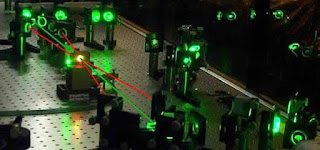Second Harmonic Generation (SHG)
Second Harmonic Generation
Second harmonic generation (SHG) is a nonlinear optical process
in some materials when exposed to intense laser light. In SHG, two photons with the same frequency combine in a material to produce a single photon with twice the energy (or half the wavelength) and twice the frequency of the original photons.
in some materials when exposed to intense laser light. In SHG, two photons with the same frequency combine in a material to produce a single photon with twice the energy (or half the wavelength) and twice the frequency of the original photons.
SHG can generate laser light at shorter wavelengths than the original laser source, which can be useful for various applications such as microscopy, spectroscopy, and laser machining. It is particularly useful when a laser with a shorter wavelength is required but unavailable, such as in the ultraviolet (UV) range.
The SHG efficiency depends on several factors, including the intensity of the incident laser, the polarization of the laser light, and the properties of the material used for the SHG. Materials that are commonly used for SHG include nonlinear crystals such as lithium niobate (LiNbO3), beta-barium borate (BBO), and potassium titanyl phosphate (KTP).
In addition to SHG, other nonlinear optical processes that can occur in materials exposed to intense laser light include third harmonic generation (THG), sum-frequency generation (SFG), and difference-frequency generation (DFG). These processes are similar to SHG but involve the combination of three or more photons rather than just two.




Comments
Post a Comment